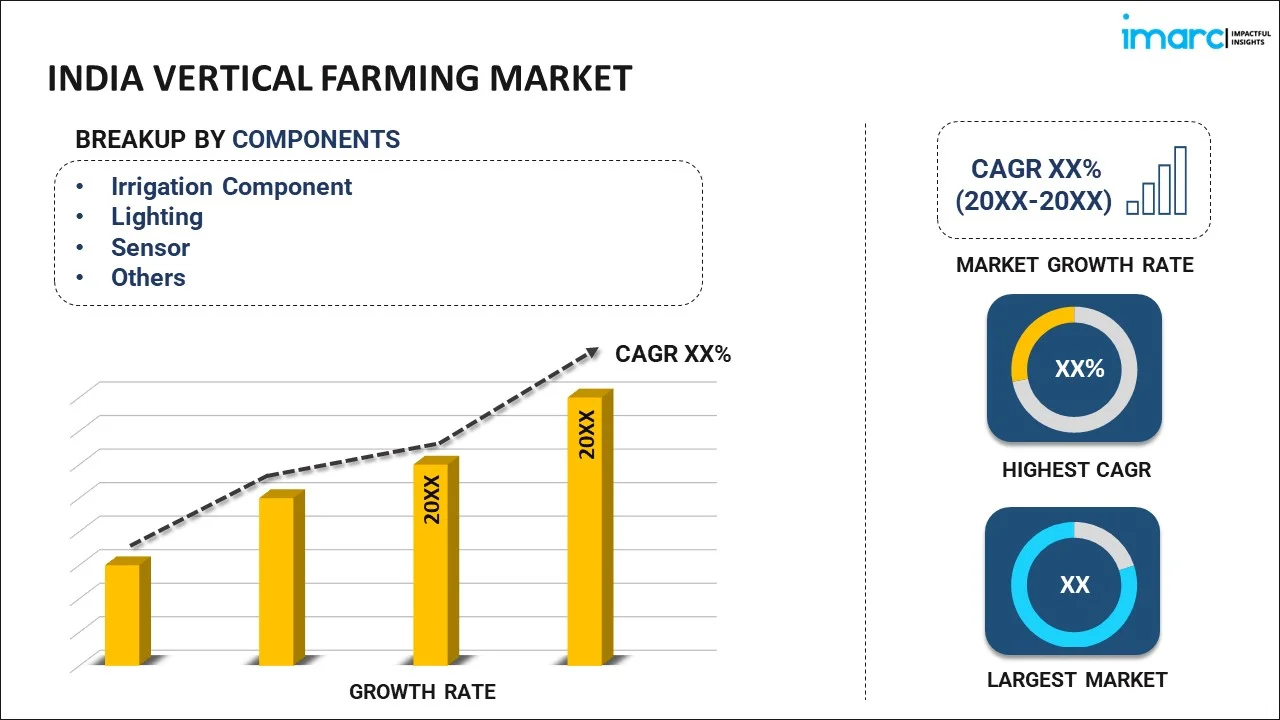
India Vertical Farming Market Report by Component (Irrigation Component, Lighting, Sensor, Climate Control, Building Material, and Others), Structure (Building-based Vertical Farms, Container-based Vertical Farms), Growth Mechanism (Hydroponics, Aeroponics, Aquaponics), Application (Indoor, Outdoor), and Region 2025-2033
Market Overview:
The India vertical farming market size reached USD 82.7 Million in 2024. Looking forward, IMARC Group expects the market to reach USD 579.7 Million by 2033, exhibiting a growth rate (CAGR) of 21.50% during 2025-2033.
|
Report Attribute
|
Key Statistics
|
|---|---|
|
Base Year
|
2024
|
|
Forecast Years
|
2025-2033
|
|
Historical Years
|
2019-2024
|
|
Market Size in 2024
|
USD 82.7 Million |
|
Market Forecast in 2033
|
USD 579.7 Million |
| Market Growth Rate (2025-2033) | 21.50% |
Vertical farming refers to the process of planting and growing crops vertically. It involves the use of various components, such as lighting, irrigation, sensor, climate control and building material. Butterhead, winter boar, chives, mint, small woody herbs, red leaf, romaine, Tuscan and basil are some of the crops grown through vertical farming. It is a nontraditional method that assists in high yield by causing negligible effect on climate, reducing the amount of pesticide usage, and consuming less water and area requirement. Due to these properties, vertical farming is considered a reliable and environmentally friendly solution, that is also highly energy-efficient and reduces transport costs.
India Vertical Farming Market Trends:
The growing need for independent farming practices across the country is creating a positive outlook for the market growth. Vertical farming is widely adopted as it requires less space and provides higher productivity. Additionally, the increasing product utilization to produce organic and good quality nutritious food as it assists in creating a stable and sustainable year-round food supply is contributing to the market growth. Apart from this, numerous technological advancements, such as the integration of the Internet of Things (IoT) with mobile and drones to provide real-time information on crop health, are providing an impetus to the market growth. The increasing demand for vertical farming can also be attributed to the rising environmental consciousness amongst farmers as it reduces the amount of land and water needed for its production, thus positively impacting the market growth. Other factors, including the scarcity of land for farming and the increasing demand for stabilized crop production irrespective of climatic changes, are anticipated to drive the market further toward growth.
Key Market Segmentation:
IMARC Group provides an analysis of the key trends in each sub-segment of the India vertical farming market report, along with forecasts at the country and regional levels from 2025-2033. Our report has categorized the market based on component, structure, growth mechanism and application.
Breakup by Component:

- Irrigation Component
- Lighting
- Sensor
- Climate Control
- Building Material
- Glass Greenhouse
- Plastic Greenhouse
- Others
Breakup by Structure:
- Building-based Vertical Farms
- Container-based Vertical Farms
Breakup by Growth Mechanism:
- Hydroponics
- Aeroponics
- Aquaponics
Breakup by Application:
- Indoor
- Outdoor
Breakup by Region:
- North India
- West and Central India
- South India
- East India
Competitive Landscape:
The competitive landscape of the industry has also been examined along with the profiles of the key players.
Report Coverage:
| Report Features | Details |
|---|---|
| Base Year of the Analysis | 2024 |
| Historical Period | 2019-2024 |
| Forecast Period | 2025-2033 |
| Units | Million USD |
| Segment Coverage | Component, Structure, Growth Mechanism, Application, Region |
| Region Covered | North India, West and Central India, South India, East India |
| Customization Scope | 10% Free Customization |
| Post-Sale Analyst Support | 10-12 Weeks |
| Delivery Format | PDF and Excel through Email (We can also provide the editable version of the report in PPT/Word format on special request) |
Key Questions Answered in This Report
We expect the India vertical farming market to exhibit a CAGR of 21.50% during 2025-2033.
The rising environmental consciousness has led to the increasing adoption of vertical farming as it reduces land and water requirement, is primarily driving the India vertical farming market.
The sudden outbreak of the COVID-19 pandemic had led to the implementation of stringent lockdown regulations across the nation resulting in temporary halt in various agricultural activities, thereby negatively impacting the vertical farming market in India.
Based on the component, the India vertical farming market has been segmented into irrigation component, lighting, sensor, climate control, building material, and others. Currently, lighting holds the majority of the total market share.
Based on the structure, the India vertical farming market can be divided into building-based vertical farms and container-based vertical farms, where container-based vertical farms exhibit a clear dominance in the market.
Based on the growth mechanism, the India vertical farming market has been categorized into hydroponics, aeroponics, and aquaponics. Among these, hydroponics currently account for the majority of the total market share.
Based on the application, the India vertical farming market can be segregated into indoor and outdoor. Currently, indoor holds the largest market share.
On a regional level, the market has been classified into North India, West and Central India, South India and East India, where South India currently dominates the India vertical farming market.
Need more help?
- Speak to our experienced analysts for insights on the current market scenarios.
- Include additional segments and countries to customize the report as per your requirement.
- Gain an unparalleled competitive advantage in your domain by understanding how to utilize the report and positively impacting your operations and revenue.
- For further assistance, please connect with our analysts.
 Inquire Before Buying
Inquire Before Buying
 Speak to an Analyst
Speak to an Analyst
 Request Brochure
Request Brochure
 Request Customization
Request Customization




.webp)




.webp)












